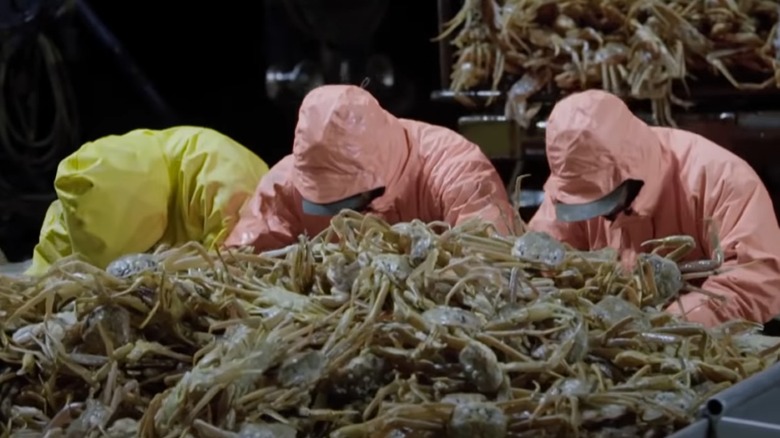Deadliest Catch Crew Members Typically Only Get Five-Minute Breaks
From "The Real Housewives" to "The Bachelor," drama is often heightened for entertainment purposes on reality television shows. As for Discovery Channel's long-running series "Deadliest Catch," it's certainly not immune from this. But for the most part, "Deadliest Catch" spotlights the raw, unfiltered lives of crab fishermen on the tumultuous Bering Sea. Who could forget deckhand Jake Anderson in tears on the F/V Northwestern as he learned of his father's mysterious disappearance? Or when the F/V Destination tragically sank, a loss that every captain and crew member mourned?
In addition to these all-too-real emotions, the hard labor and not-so-cozy living conditions that come with being part of a ship's crew are also highlighted. Alaska's Bering Sea features rough waves, freezing conditions, and the occasional storm that can turn dangerous in the blink of an eye. Through all this, captains and crew members must keep up the pace of filling pots, otherwise, the months spent away from loved ones would be for naught.
This job involves putting in hard work every single day while out at sea. One might assume that these guys get ample break times to not overexert themselves, but that assumption is far from the truth. In fact, they have minimal time to rest, eat, and sleep.
Crews only have time to microwave a quick meal
To anyone who has watched even one episode of "Deadliest Catch," it's clear that the deckhands don't exactly have the most glamorous job in the world. They're cold, wet, and hauling pots of crabs for hours on end. During a tour of his F/V Wizard, Captain Keith Colburn provided further insight into the intense working conditions.
While showing off the kitchen, he explained that the refrigerator is stocked with food, but the guys typically utilize the boat's two microwaves rather than the stove. Why? "Because a five-minute break isn't enough time to eat a big meal," Colburn told SeattleInsider. He also added, "This is not a pleasure craft. It's an industrial workboat."
On top of almost non-existent breaks, crews are also operating on very little sleep. As reported by Men's Journal, crab fishermen usually pull 18-hour days, from 6 a.m. to midnight. According to writer Andy Cochrane, who experienced a seasick-fueled week on the Bering Sea while on assignment, this lifestyle is second nature for the crew he shadowed. "Not once did I hear any of them complain," said Cochrane. "In fact, much the opposite. The group was as proud, positive and hard-working as it gets."
There are a number of reasons why one might choose this career path over a typical 9-to-5. Many, like Northwestern captain Sig Hansen, are following in the footsteps of fathers and grandfathers. Others enjoy the idea of bringing home an impressive paycheck, which for deckhands can range from $15,000 to $50,000 over the span of a few months, as F/V Dungeon Cove captain Kenny Ripka told People. No matter the reason, one thing is clear: their jobs clearly make for riveting television.

